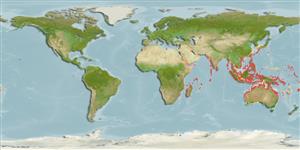Common names from other countries
Classification / Names / Names
ماع يماسا | فدارتم | Catalog of Fishes (gen., sp.) | ITIS | CoL | WoRMS
Environment: milieu / climate zone / depth range / distribution range
يسانش موب
; قمع تارييغت 0 - 30 m (Ref. 349). Tropical
Indo-West Pacific: from East Africa to Melanesia; north to Japan and south to southern Queensland.
Length at first maturity / Size / Weight / نس
Maturity: Lm ? range ? - ? cm Max length : 14.5 cm SHL يسنج صاوخ نودب / رن سنج; (Ref. 349); common length : 11.0 cm SHL يسنج صاوخ نودب / رن سنج; (Ref. 349)
No precise data on fisheries, but the species is currently sold in markets in East Africa (Ref. 349). Occurs at the low tide mark (Ref. 349).
Life cycle and mating behavior
غولب | لثم دیلوت | یزیر مخت | اه مخت | Fecundity | )ورال ( دازوت
Members of the order Neotaenioglossa are mostly gonochoric and broadcast spawners. Life cycle: Embryos develop into planktonic trocophore larvae and later into juvenile veligers before becoming fully grown adults.
یلصا ذخآم
عجارم | هدننك گنهامه | ناراكمه
Poutiers, J.M. 1998. (Ref. 349)
NCUI زمرق تسرهف رد تيعضو (Ref. 130435)
ستياس رظن زا تيعضو (Ref. 108899)
Not Evaluated
Not Evaluated
اه ناسنا یارب رطخ
Harmless
یناسنا هدافتسا
| FishSource |
اهرازبا
رتشيب تاعالطا
Age/Sizeدشرنزو - لوطلوط - لوطيسانش تخير)ورال ( دازوتيناوارف
يتنرتنيا عبانم
Estimates based on models
Preferred temperature
(Ref.
115969): 23.7 - 29.3, mean 28.4 (based on 3458 cells).
یريذپ بيسآ
Low vulnerability (10 of 100).
تميق هقبط
Unknown.
